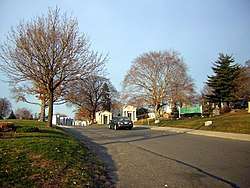Cemetery of the Evergreens
|
Evergreens Cemetery | |
 Southern (Bushwick Avenue) entrance | |
   | |
| Location | 1629 Bushwick Ave., Brooklyn, New York |
|---|---|
| Coordinates | 40°41′2.0″N 73°54′4.3″W / 40.683889°N 73.901194°WCoordinates: 40°41′2.0″N 73°54′4.3″W / 40.683889°N 73.901194°W |
| Area | 225 acres (91 ha) |
| Built | 1849 |
| Architect | Vaux, Calvert; etc |
| NRHP reference # | 07001192[1] |
| Added to NRHP | November 15, 2007 |
The Cemetery of the Evergreens is a non-denominational cemetery in Brooklyn and Queens, New York, colloquially called Evergreen Cemetery. It was incorporated in 1849, not long after the passage of New York's Rural Cemetery Act spurred development of cemeteries outside Manhattan. For a time, it was the busiest cemetery in New York City; in 1929 there were 4,673 interments. The cemetery borders Brooklyn and Queens and covers 225 acres (0.91 km2) of rolling hills and gently sloping meadows. It features several thousand trees and flowering shrubs in a park-like setting. The Evergreens is the final resting place of more than 526,000 people.[2]
History
The Evergreens was built on the principle of the rural cemetery. Two of the era's most noted landscape architects, Andrew Jackson Downing and Alexander Jackson Davis, were instrumental in the layout of the cemetery grounds.
The Evergreens has a monument to six victims of the Triangle Shirtwaist Factory fire of March 25, 1911 who were unidentified for nearly a century. In 2011, Michael Hirsch, a historian, completed four years of research that identified these victims by name (see Group monument, below).[3][4]
There are also 17 British Commonwealth service personnel buried in the cemetery, 13 from World War I and 4 from World War II.[5]
The cemetery was listed on the National Register of Historic Places on November 15, 2007.[1] Cypress Hills Cemetery lies to its northwest.
Notable burials
Individual graves
- John Bunny (1863–1915), actor
- Anthony Comstock (1844–1915), censor (see Comstock Law)
- Bill Dahlen (1870–1950), Major League Baseball player, one of the outstanding early 20th century players. Lies in an unmarked grave.
- James E. Davis (1962–2003), New York City councilman (he was originally interred in Green-Wood Cemetery, but after it was realized that his assassin was also interred there, he was moved to the Cemetery of the Evergreens)
- George Henry Ellis (1875–1898), A chief yeoman on the USS Brooklyn
- Alice Fleming Day (1882–1952), actress, stage and screen
- Effie Germon (1845–1914), Stage actress descended from the Germons of Baltimore, an old theatrical family
- John D. Germon (1840–1901), Stage actor descended from the Germons of Baltimore, an old theatrical family; brother of Effie Germon
- Adelaide Hall (1901–1993), singer, actress, dancer, nightclub chanteuse
- George Hall (1849–1923), Major League Baseball player, banned from baseball for life
- Yusef Hawkins (1973–1989), murder victim
- Martin Johnson Heade (1819–1904), artist
- Lucille Hegamin (1894–1970), singer, female pioneer of the Blues
- William Hickey (1927–1997), actor
- Joseph Forsyth Johnson (1840–1906), landscape architect and great-grandfather of Bruce Forsyth
- Walt Kelly (1913–1973), cartoonist
- George H. Lindsay (1837–1916), congressman
- George W. Lindsay (1865–1938), congressman, his son
- Winsor McCay (1872–1934), cartoonist and animated cartoon pioneer
- Antonio "Tony" Pastor (1837–1908), vaudevillian
- Julia Smitten Reinhardt (1844–1924), stage actress and suffragist
- Sante Righini (1883–1912), died on the Titanic[6]
- Bill "Bojangles" Robinson (1878–1949), tap dancer
- Stephen A. Rudd (1874–1936), congressman
- Joseph Thuma Schenck (c. 1891–1930), vaudevillian, better known as "Joe" Schenck, of the comedy singing team Van and Schenck
- William Steinitz (1836–1900), world chess champion
- Bob Thiele (1922–1996), record producer
- Amy Vanderbilt (1908–1974), journalist, etiquette authority
- Oscar Walker (1854–1889), Major League Baseball player
- John William Warde (c.1912–1938), his widely publicized suicide inspired the movie Fourteen Hours.
- Thomas "Blind Tom" Wiggins (1849–1908), musician
- Lester Young (1909–1959), jazz musician
- Charles A. Read (1837–1865), American Civil War Medal of Honor recipient
Group monument
- Triangle Shirtwaist fire – the bodies of six victims of the 1911 fire to be identified were buried under a monument of a kneeling woman. They could not be identified after the inferno because they were burned beyond recognition, and had been buried without names. A century after the tragedy, in 2011, they were identified by historian Michael Hirsch as Maria Giuseppa Lauletti, Max Florin, Concetta Prestifilippo, Josephine Cammarata, Dora Evans, and Fannie Rosen.[4][7]
See also
References
- 1 2 National Park Service (2010-07-09). "National Register Information System". National Register of Historic Places. National Park Service.
- ↑ "Cultural Resource Information System (CRIS)" (Searchable database). New York State Office of Parks, Recreation and Historic Preservation. Retrieved 2016-05-01. Note: This includes Kathleen A. Howe (August 2007). "National Register of Historic Places Registration Form: Evergreens Cemetery" (PDF). Retrieved 2016-05-01. and Accompanying 26 photographs
- ↑ Berger, Joseph (February 21, 2011). "100 Years Later, the Roll of the Dead in a Factory Fire Is Complete". New York Times. p. 13. Retrieved 23 April 2017.
- 1 2 "The Fire That Changed Everything". The New York Times. February 22, 2011. Retrieved 2011-11-04.
- ↑ CWGC Cemetery Report. Breakdown obtained from casualty record.
- ↑ Schapiro, Rich; Egan-Chin, Debbie (April 11, 2017). "Hunt for Grave of Heroic Titanic Victim Leads Researcher to Brooklyn Cemetery". New York Daily News. Retrieved 11 April 2017.
- ↑ Berger, Joseph (February 21, 2011). "In Records, Portraits of Lives Cut Short". New York Times. p. A16. Retrieved 23 April 2017.
Further reading
- Rousmaniere, John. Green Oasis in Brooklyn: The Evergreens Cemetery 1849–2008. (2008) ISBN 978-0-9786899-4-0

